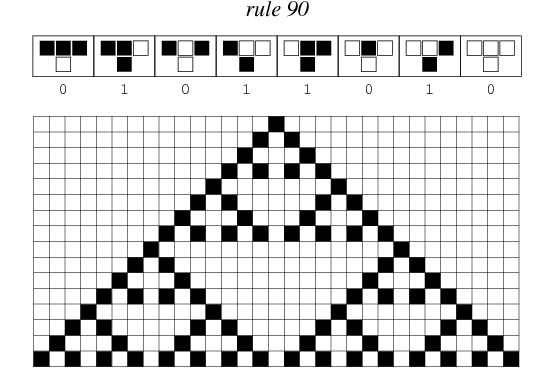


 تاريخ الرياضيات
تاريخ الرياضيات
 الرياضيات في الحضارات المختلفة
الرياضيات في الحضارات المختلفة 
 الرياضيات المتقطعة
الرياضيات المتقطعة
 الجبر
الجبر
 الهندسة
الهندسة 
 المعادلات التفاضلية و التكاملية
المعادلات التفاضلية و التكاملية 
 التحليل
التحليل
 علماء الرياضيات
علماء الرياضيات |
Read More
Date: 20-8-2021
Date: 16-9-2021
Date: 15-12-2021
|

Rule 90 is one of the elementary cellular automaton rules introduced by Stephen Wolfram in 1983 (Wolfram 1983, 2002). It specifies the next color in a cell, depending on its color and its immediate neighbors. Its rule outcomes are encoded in the binary representation  . This rule is illustrated above together with the evolution of a single black cell it produces after 15 steps (Wolfram 2002, p. 55).
. This rule is illustrated above together with the evolution of a single black cell it produces after 15 steps (Wolfram 2002, p. 55).
Starting with a single black cell, successive generations are given by interpreting the numbers 1, 5, 17, 85, 257, 1285, 4369, 21845, ... (OEIS A038183) in binary, namely as 1, 101, 10001, 1010101, 100000001, ... (OEIS A070886).
Rule 90 is amphichiral, and its complement is rule 165.

The fractal produced by this rule was described by Sierpiński in 1915 and appearing in Italian art from the 13th century (Wolfram 2002, p. 43). It is therefore also known as the Sierpiński sieve, Sierpiński gasket, or Sierpiński triangle. The binomial coefficient  mod 2 can be computed using the XOR operation
mod 2 can be computed using the XOR operation  XOR
XOR  , making Pascal's triangle mod 2 very easy to construct. Moreover, coloring all odd numbers black and even numbers white in Pascal's triangle produces a Sierpiński sieve (Guy 1990; Wolfram 2002, p. 870).
, making Pascal's triangle mod 2 very easy to construct. Moreover, coloring all odd numbers black and even numbers white in Pascal's triangle produces a Sierpiński sieve (Guy 1990; Wolfram 2002, p. 870).

Rule 90 is one of the eight additive elementary cellular automata (Wolfram 2002, p. 952).
REFERENCES:
Guy, R. K. "The Second Strong Law of Small Numbers." Math. Mag. 63, 3-20, 1990.
Sloane, N. J. A. Sequences A038183 and A070886 in "The On-Line Encyclopedia of Integer Sequences."
Wolfram, S. "Statistical Mechanics of Cellular Automata." Rev. Mod. Phys. 55, 601-644, 1983.
Wolfram, S. A New Kind of Science. Champaign, IL: Wolfram Media, pp. 90, 55, 870, and 952, 2002.



|
|
|
|
"عادة ليلية" قد تكون المفتاح للوقاية من الخرف
|
|
|
|
|
|
|
ممتص الصدمات: طريقة عمله وأهميته وأبرز علامات تلفه
|
|
|
|
|
|
|
المجمع العلمي للقرآن الكريم يقيم جلسة حوارية لطلبة جامعة الكوفة
|
|
|